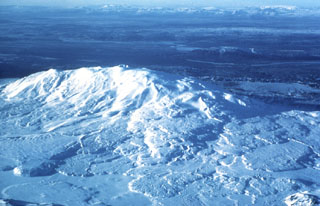Report on Hekla (Iceland) — June 2000
Bulletin of the Global Volcanism Network, vol. 25, no. 6 (June 2000)
Managing Editor: Richard Wunderman.
Hekla (Iceland) Clarification of NASA airborne plume experiments on 29 February 2000
Please cite this report as:
Global Volcanism Program, 2000. Report on Hekla (Iceland) (Wunderman, R., ed.). Bulletin of the Global Volcanism Network, 25:6. Smithsonian Institution. https://doi.org/10.5479/si.GVP.BGVN200006-372070
Hekla
Iceland
63.983°N, 19.666°W; summit elev. 1490 m
All times are local (unless otherwise noted)
NASA's Dryden Flight Research Center (DFRC) advised that information concerning two flights of their DC-8 aircraft as reported in BGVN 25:02 contained errors and requested that the information be corrected with additional details as follows:
"For approximately seven minutes starting at 0510 during a transit flight on 29 February to Kiruna, Sweden, a NASA DC-8 aircraft with a payload of SOLVE (SAGE III Ozone Loss and Validation Experiment) sensors flew through the plume ~11.3 km NNE of Iceland at 76 °N and 5 °W, just off the Greenland coastline. The plume extended up to ~13 km altitude, well into the lower stratosphere. The aircraft passed thorough the volcanic ash far N and W, and at a flight level much higher, than the predictions reported by the Volcanic Ash Advisory Center (VAAC), London. Instruments measured many in situ trace gases, SO2, HNO3, NO, NOy, O3, volatile and non-volatile aerosols, and aerosol size distribution. The scientific team reported substantial increases in CN, NOy, HNO3, CO, and particle counts, O3 went to nearly zero, H2O increased, and strong scattering layers up to 13 km were detected.
"A flight on 5 March detected enhanced aerosols and SO2 at 1301, but by that time the plume was so diluted that it represented no danger to the aircraft. During the three weeks following the initial encounter the DC-8 detected remnants of the plume trapped within the polar vortex. The resulting analysis concluded that volatile aerosols increased and the sizes of non-volatile large aerosols decreased."
NASA-DFRC also advised that the statement about the plume being a "very impressive, orange, airfoil-shaped feature in the pre-dawn sky" was erroneous. Post-flight interviews with the pilot indicated that there was no moon out, therefore pitch black sky conditions existed at the time of the encounter. The pilots had no visual evidence of flying into the plume.
Geological Summary. One of Iceland's most prominent and active volcanoes, Hekla lies near the southern end of the eastern rift zone. Hekla occupies a rift-transform junction, and has produced basaltic andesites, in contrast to the tholeiitic basalts typical of Icelandic rift zone volcanoes. Vatnafjöll, a 40-km-long, 9-km-wide group of basaltic fissures and crater rows immediately SE of Hekla forms a part of the Hekla-Vatnafjöll volcanic system. A 5.5-km-long fissure, Heklugjá, cuts across the 1491-m-high Hekla volcano and is often active along its full length during major eruptions. Repeated eruptions along this rift, which is oblique to most rifting structures in the eastern volcanic zone, are responsible for Hekla's elongated ENE-WSW profile. Frequent large silicic explosive eruptions during historical time have deposited tephra throughout Iceland, providing valuable time markers used to date eruptions from other Icelandic volcanoes. Hekla tephras are generally rich in fluorine and are consequently very hazardous to grazing animals. Extensive lava flows from historical eruptions, which date back to 1104 CE, cover much of the volcano's flanks.
Information Contacts: Gary Shelton, NASA, Dryden Flight Research Center, P.O. Box 273, Edwards, CA 93523-0273 USA.

